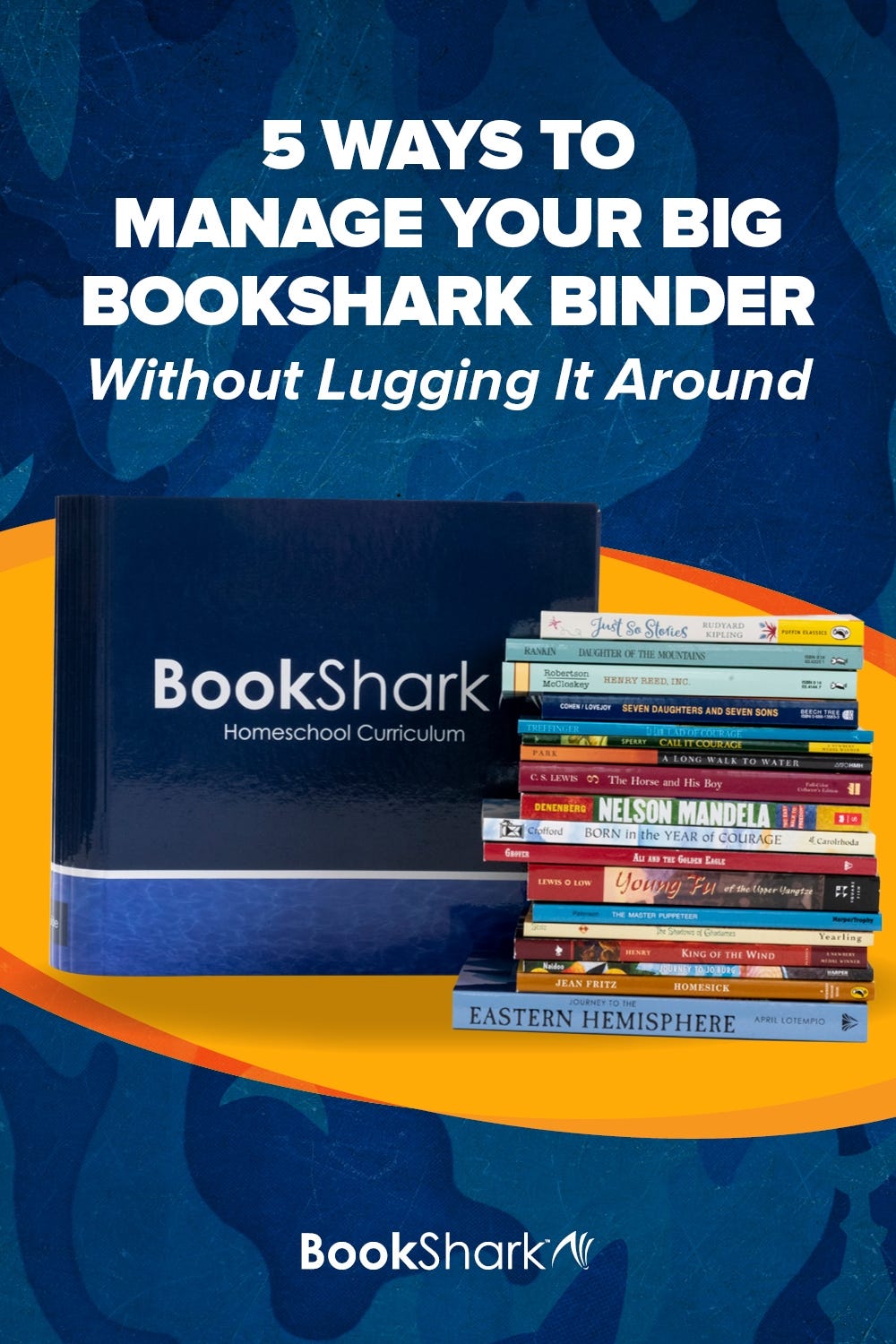




5 Ways to Manage Your Big BookShark Binder without Lugging It Around

The BookShark binder* is huge. It has to be to fit all of the information, lessons, and activity sheets included in the 36-week curriculum. We need the Instructor’s Guide that goes in the binder, but thankfully we don’t need to lug it around.
There are several ways we can keep our BookShark materials organized and accessible without wrangling a 3-inch notebook. If you’re like me and prefer to keep the big binder on the shelf, all you have to do is choose one of these five solutions.
1. Use a Working Binder
A working binder is exactly what its name suggests: a binder that holds the things your homeschoolers are currently working on.
This method works well if you plan units or like to build breaks into your homeschool year every six or eight weeks. Transfer the lessons to a smaller binder and when your child is finished with them, swap them for a new set of materials.
A working binder is also a great tool if you are using several different BookShark programs. Keep your current history, writing, science, and math units together, so you always have on hand exactly what you and your student need.
2. Use a Filing Crate with Hanging Files
Some of us are just not binder people. It’s okay!
A hanging file system is another great way to organize your BookShark curriculum. All you need to do is put each weekly lesson into a separate file folder. If you have multiple homeschoolers, you might put their weekly lessons in the same folder so that you can grab one file at a time. Or you can choose different colored folders for each child.
Once you finish a lesson, move the file to the back of the crate or cabinet. Your homeschooler’s next set of lessons is now right up front, ready for them.
3. Use a Kids Binder and an Adult Binder
My child loves school supplies and would be very upset if I were the only one with a binder. So she gets her own notebook, too. tory. Use reading strategies to craft your questions and discussions:

I always put all of her activity sheets in one binder and my Instructor’s Guide in another. She also likes to organize her supplies by subject, so her BookShark history lessons and writing assignments are in one binder while her BookShark science lessons are in another. These binders don’t have to be very big and give her the autonomy (and school supplies) she craves. They also lighten the load on my binder.
4. Spiral Bind Each Unit
If you love to keep curriculum long-term, spiral binding each unit or several units is a beautiful way to save and showcase the lessons. Spiral-binding might be an easier way to travel with units or for younger children to use the materials.
Systems like the Happy Planner also allow you to punch holes into the materials and use plastic rings to bind the lessons together.
5. Pull Out What You Need Each Week
Perhaps the easiest way to keep yourself from lugging around your big BookShark binder is to pull out what you’ll need each week. Keep the materials in a folder or separate binder—whatever works for you. At the end of the week, put everything back into the big binder and pull out what you’ll need next week.
Practically speaking, the big binder is massive and takes up a good amount of space on the table.
There is another reason you might consider downsizing your binder: Some children get overwhelmed by seeing everything they will need to do in a year. Seeing a manageable amount of activity sheets or reading may dissipate the shock factor. If you feel overwhelmed by the number of lessons, it might help you feel less stressed as well.
Remember, homeschooling is not a race, and the BookShark curriculum is a guide. For some of us, it takes many more weeks or months to finish. And that’s okay! Staying organized and biting off (or filing) manageable amounts of materials can help. The most important thing is you use your curriculum how it works best for you and your homeschooler. .

*A BookShark binder is included in the Required Resources for All-Subject and Reading with History Packages.
About the Author
Kelly left teaching middle and high school English to homeschool her children and reclaim how she and her family spent their time. Followers of interest-led learning, her family’s days rarely look the same, but they tend to include a lot of books, art supplies, and time outside.
Kelly facilitates local writing circles for women and children and blogs about nurturing the love of learning on her blog, Curiosity Encouraged. She loves to journal, read memoirs, hike, and travel. She seeks quiet mornings and good coffee daily.
